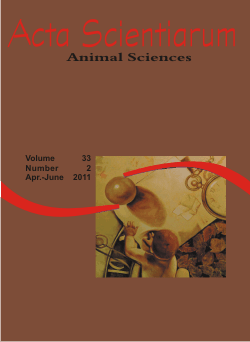<b>Yield and chemical composition of <em>Brachiaria brizantha</em> cv. MG-4 under the effect of NPK fertilization</b> - doi: 10.4025/actascianimsci.v33i2.9392
Keywords:
Phosphorus, nitrogen, potassium, crude protein
Abstract
The objective of this work was to evaluate the effects of combinations of nitrogen (N), phosphorus (P) and potassium (K) on the dry matter yield and chemical composition of Brachiaria brizantha cv. MG-4. The experiment consisted of 16 combination levels of NPK, according to experimental matrix Plan Puebla II, in a completely randomized design with five replications. It used a dystrophic Red Yellow Sand-Argisol; ammonium and urea sulfate, triple super phosphate and potassium chloride were used as sources of N, P and K, respectively. The harvested material was separated into leaves and stem and submitted to dry matter yield (DMY) evaluations of the aerial part, crude protein (CP) and determination of the contents of N, P and K. In general, fertilization promoted beneficial effects on the grass, whose level of 360-370-360 g pot-1 of NPK, respectively, provided 95% of the highest total DMY. The maximum yields were obtained with the application of 373, 407 and 317 mg dm-3 of N for total, leaf, and stem DM, respectively. The levels of N led to increased levels of leaf CP. The concentrations of leaf CP were higher than the concentration found in the stems.Downloads
Download data is not yet available.
Published
2011-04-28
How to Cite
Teles, T. G. R. M., Carneiro, M. S. de S., Soares, I., Pereira, E. S., Souza, P. Z. de, & Magalhães, J. A. (2011). <b>Yield and chemical composition of <em>Brachiaria brizantha</em> cv. MG-4 under the effect of NPK fertilization</b> - doi: 10.4025/actascianimsci.v33i2.9392. Acta Scientiarum. Animal Sciences, 33(2), 137-143. https://doi.org/10.4025/actascianimsci.v33i2.9392
Issue
Section
Pasture and forage utilization
DECLARATION OF ORIGINALITY AND COPYRIGHTS
- I Declare that current article is original and has not been submitted for publication, in part or in whole, to any other national or international journal.
The copyrights belong exclusively to the authors. Published content is licensed under Creative Commons Attribution 4.0 (CC BY 4.0) guidelines, which allows sharing (copy and distribution of the material in any medium or format) and adaptation (remix, transform, and build upon the material) for any purpose, even commercially, under the terms of attribution.
Read this link for further information on how to use CC BY 4.0 properly.
0.9
2019CiteScore
29th percentile
Powered by 








































